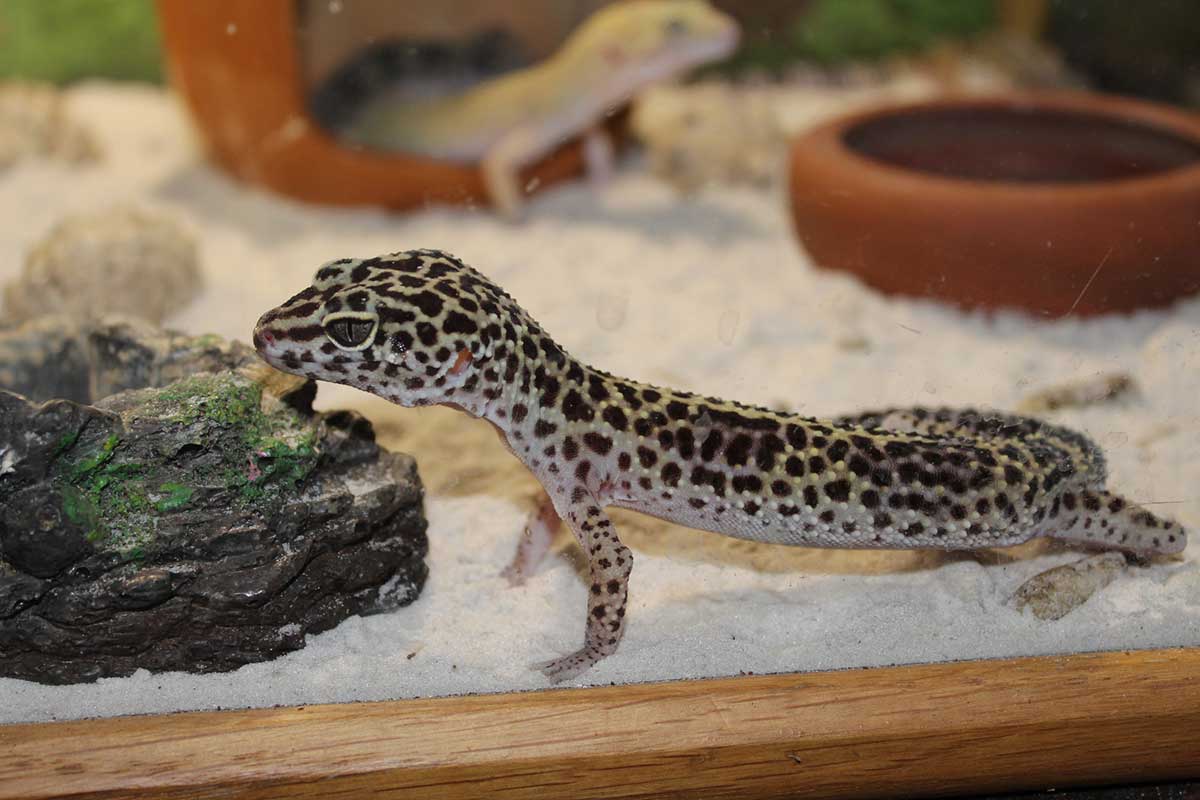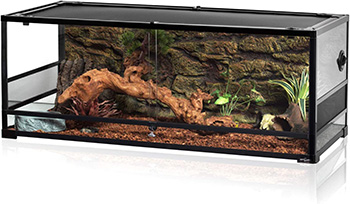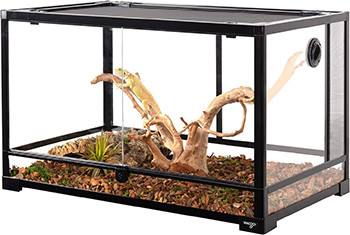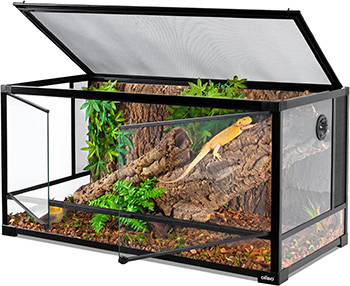When bringing wild animals into captivity, one thing that will have an enormous impact on their quality of life is the size of their home.
In the case of your leopard gecko, that means their tank or terrarium. If it’s too small, they can start to feel stressed and claustrophobic, and it can stunt their growth, resulting in serious health conditions.
But how big of a tank does your leopard gecko need? The short answer is 20 gallons as an absolute minimum, but larger is better!
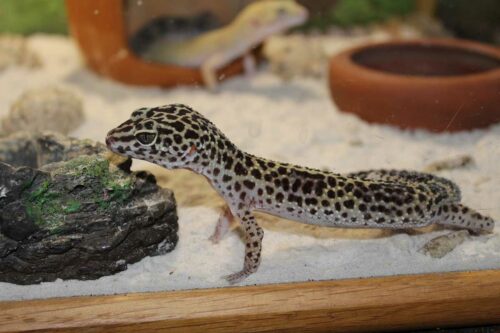
However, babies and juveniles can live in smaller tanks while they’re growing. And if you plan on keeping multiple geckos together, you’ll need a much bigger tank!
In addition to its size, we’ll also cover what features your tank needs to be suitable for your leopard gecko. No, a fish tank will not do!
We’ll also share our top three recommendations for the best leopard gecko tanks available for under $400.
Leopard Gecko Tank Size Guide
The larger their tank, the happier your leopard gecko will be. In the wild, these reptiles are accustomed to covering vast distances in their search for food and a mate.
So, no matter how big you make the tank, they won’t feel overwhelmed. But, of course, for most people it’s not realistic to have a 200-gallon tank in their living room.
So let’s talk about minimum size—the absolute minimum amount of space your leopard gecko will need not to feel claustrophobic.
In addition to being a source of stress, if their tank is too small, it can stunt their growth, which can then result in avoidable medical issues.
So, how big is big enough?
Within the first six to nine months of your leopard gecko’s life, you can probably get away with a 10-gallon tank.
It is not uncommon for new reptile parents to get a small tank for the baby and then spend a few months creating a larger and more permanent habitat for their gecko to move into.
But if you don’t want to have to buy a new tank in six months time, you’re better off going directly for a full-size tank.
A single adult leopard gecko needs a tank that is at least 20 gallons in volume. Tanks that are broader rather than taller are a better option because leopard geckos aren’t climbers, so they’ll appreciate the flat grounds to move around on.
If you aren’t sure how old your leopard gecko is, this is fairly predictable based on their size. See the age and size chart below to give you a good indication of the expected size of a leopard gecko at any given age.
As you can see, once they get to about seven to eight inches, which is fully grown for females, they need to be moved from a juvenile tank into an adult tank. Males can grow up to 12 inches in length and will struggle in anything less than 20 gallons.
| Age | Size | Weight |
|---|---|---|
| 0 Months | 3 inches | 2-4 grams |
| 1 Month | 4-5 inches | 15-25 grams |
| 2-3 Months | 5-5.5 inches | 20-30 grams |
| 4-5 Months | 5.5-6 inches | 25-35 grams |
| 6-7 Months | 6-6.5 inches | 30-40 grams |
| 8-9 Months | 7-7.5 inches | 35-45 grams |
| 10-12 Months | 7.5-8 inches | 40-50 grams |
| 18 Months+ | 8-12 inches | 60-90 grams |
Housing Multiple Leopard Geckos
While leopard geckos do live in colonies in the wild, it’s not recommended to keep multiple geckos together in the same tank.
Males can get very aggressive with one another, especially during mating season. Along with unhealthy dominance behavior, fights can result in serious injuries to the smaller of the two males.
You can house males and females together, but this is not recommended unless you’re intending to breed.
You can also house females together, though there is an increased risk of issues with egg laying when multiple females are laying unfertilized eggs.
If you do choose to keep multiple geckos together, make it a maximum of three, otherwise they probably won’t feel like they have enough space. You need to add a minimum of five gallons more for every gecko that you add to the tank.
When setting up your tank, it’s also important to have multiple hiding areas set up in different corners of the tank. When it comes to nestling in, your leopard gecko will want to seek out a private area that’s a fair distance from the other geckos in the tank.
Tank Requirements
We’ve been using the word “tank” to refer to the space that encloses your gecko’s habitat, and this comes from fish tanks, which look very similar but are actually quite different from reptile homes.
They should more accurately be called terrariums to distinguish them from fish tanks. While many people do use a fish tank as a home for their gecko, it’s not the best choice since they’re not designed with air flow in mind.
The best terrariums are made of glass. Glass won’t absorb stains and smells, meaning it’s easy to keep clean. Clear glass also gives you a very good view of your reptile friend.
It’s also good at retaining heat from lamps and naturally creates differentially heated areas within the terrarium, allowing your gecko to seek out the temperature they want.
Your terrarium should be heated to around 75-85 degrees Fahrenheit during the day and about 10 degrees lower at night.
While wood terrariums have a rustic feel, they aren’t recommended because they can be difficult to clean and quickly become breeding grounds for germs and bacteria.
Plastic is also not recommended since there can be toxins in the plastic that are released over time, especially when exposed to heat, such as via the occupant’s heat lamp.
When looking for a terrarium, it’s best to choose something with a mesh top that allows good air flow but will prevent your leopard gecko from escaping or another pet from getting in.
It’s also recommended to get a terrarium that opens from the front rather than the side. While this might be less convenient for you when it comes to accessing your leopard gecko’s enclosure, it is more comfortable for them.
Entering their terrarium from above can be a source of stress for your gecko, since in the wild, all of their predators, such as birds and small mammals, attack from above.
Read our guide to feeding your leopard gecko here.
Best Leopard Gecko Terrariums Under $400
Below are recommendations for three of the best terrariums you can get for an adult leopard gecko, all for under $400.
If you have the budget, there are much more sophisticated options, but they can easily cost upward of $1,000 before you even put anything inside.
Repti Zoo 67-Gallon Reptile Terrarium
4.7 stars – 669 Reviews
This 67-gallon tank will give your leopard gecko lots of space to move around, especially since it has a large footprint (48 inches by 18 inches), rather than being overly tall.
The tank itself is made from thick, high-hardness tempered glass, and it has a mesh lid and mesh panels on the side of the tank for superior ventilation. It also has a front-opening sliding door for ideal access.
The terrarium is intelligently designed with access points for wiring for lights, ventilation control systems, and easy-to-follow instructions for mounting and dismounting the terrarium.
This is probably the very best terrarium that you’ll find for under $300 and is from the reliable brand Repti Zoo.
Wacool Tempered Glass 40-Gallon Reptile Tank
4.3 stars – 117 Reviews
This modestly sized tank is a good choice for a single leopard gecko. It has a base 30 inches by 18 inches, giving them enough space to roam. Larger options are also available.
The tank is made from tempered glass, which is both sturdy and looks good. It has a mesh roof and a mesh insert on one side for better air ventilation. Access is from the front via a lockable sliding door.
The tank is designed with six prepared inlet holes for wires and tubing so that your setup is safe and organized.
This is a great affordable home option for your leopard gecko.
OIIBO 70-Gallon Reptile Glass Terrarium
5 stars – 3 Reviews
This terrarium is from a lesser-known brand, but customers who’ve bought that terrarium give it stellar reviews and it has lots of great features.
This is a large 70-gallon tank with a footprint of 40 inches by 20 inches, which is ideal for a leopard gecko.
Made from high-quality, thick tempered glass, it has a mesh lid and mesh inserts at the side for ventilation. There’s access to the interior of the tank via two swing doors at the front as well as the mesh lid.
The front doors can also be removed for better access when giving the area a thorough clean.
Like the other tanks on this list, the OIIBO has a waterproof bottom, which is important when misting. It also comes with a one-year after-sale service and warranty.
This knock-down tank is ideal for most reptile parents and we hope to see other options like this on the market at an affordable price.
Leopard Gecko Tank Size FAQs
Is a 10-gallon tank big enough for one leopard gecko?
No, a 10-gallon tank is too small for an adult leopard gecko. They need an absolute minimum of 20 gallons to thrive in captivity.
Babies and juveniles up to the age of about nine months can be kept in a 10-gallon tank, but as they approach full maturity, they’ll need to be moved to a larger tank.
Is a 20-gallon tank big enough for a leopard gecko?
A 20-gallon tank is the minimum recommended size for creating a habitat for an adult leopard gecko. But, if you can go a bit larger, they will definitely enjoy the extra space.
What is the best size tank for two leopard geckos?
If you decide to keep two adult leopard geckos together, you need a tank that is at least 25 gallons. This is 20 gallons for the first gecko and an additional five gallons for every other gecko that you introduce into the habitat.
It is not recommended to keep multiple leopard geckos together as they do better on their own.
But if you do choose to keep multiple leopard geckos, do not keep two males in the same terrarium. In the confines of their habitat, they will probably develop unhealthy dominant behaviors and the possibility of fights and injuries is high.
Do leopard geckos prefer long or tall tanks?
Leopard geckos prefer long tanks because they aren’t climbers, so extra height largely goes to waste. Shallow tanks with lots of room to walk around are the best option for these reptiles.
Setting Up Your Gecko’s Habitat
Creating a healthy habitat for your leopard gecko starts with getting them a tank that is large enough for them to feel like they have enough space. This means an absolute minimum of 20 gallons, but they will be much happier in a larger tank.
Once you have your tank, you need to think about things like lighting and heating, substrate material, and places for your gecko to sleep and hide. You can find guides on topics like this in the geckos section of our site.
Really, we recommend getting the largest tank that you have the budget and space for in your home.
- Can Guinea Pigs Eat Potatoes? Foods To Avoid - September 24, 2023
- Can Guinea Pigs Eat Carrots? Feeding Advice - September 23, 2023
- How To Make A DIY Bearded Dragon Enclosure - September 22, 2023

